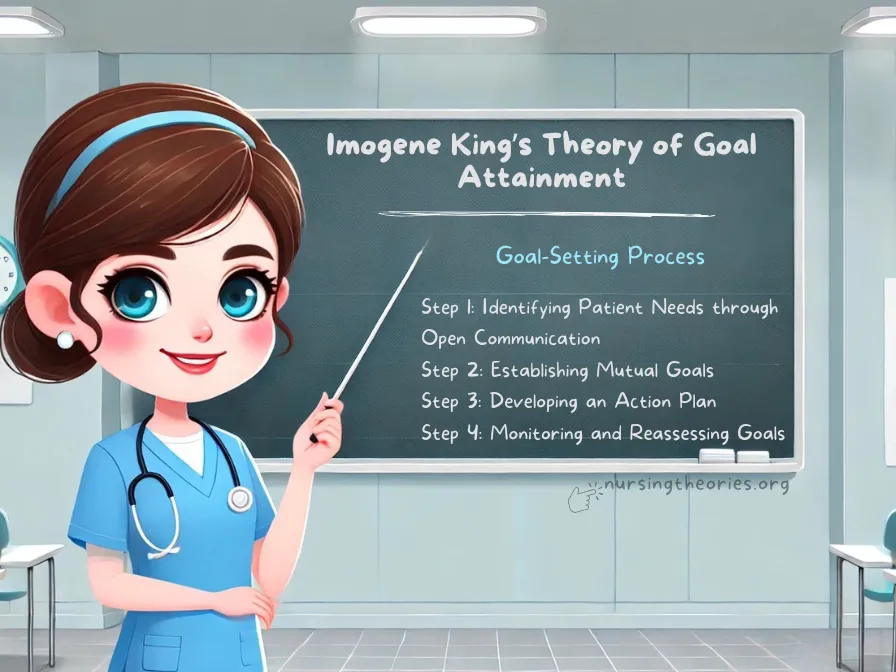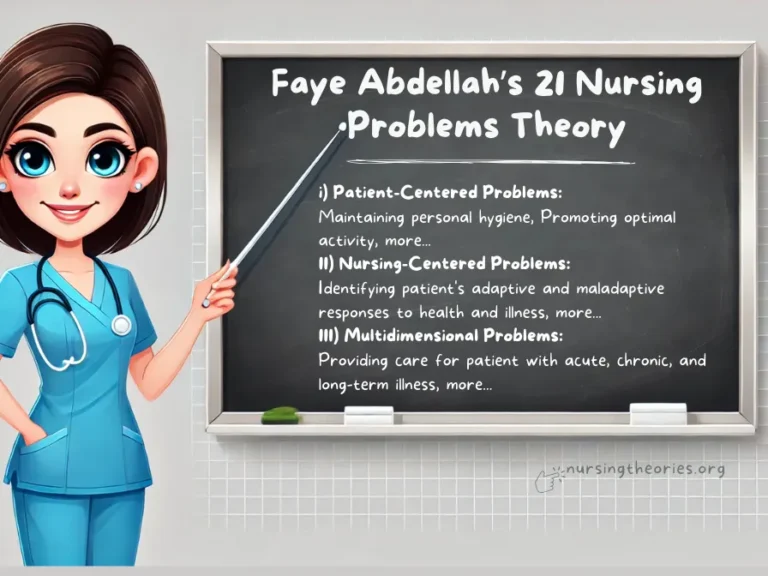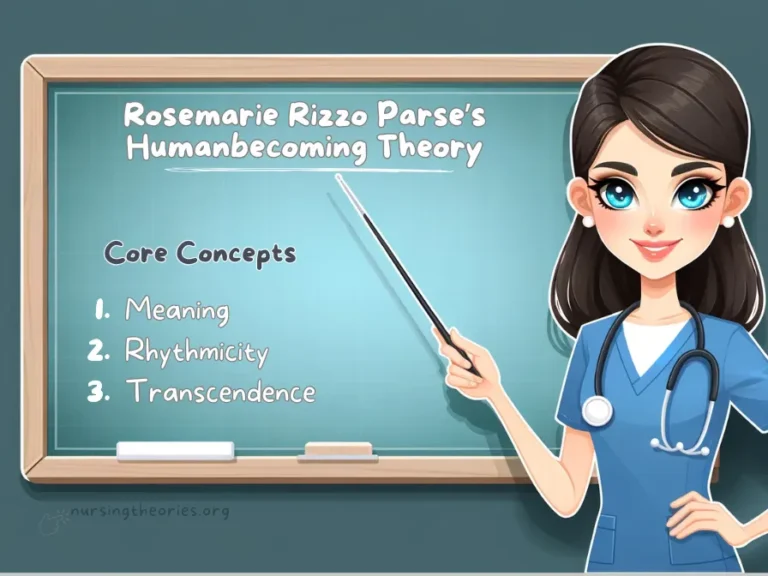Imogene King, a visionary nurse theorist and educator, made groundbreaking contributions to nursing with her Theory of Goal Attainment, which emphasizes collaboration between nurses and patients to achieve optimal health outcomes.
Her theory stresses the importance of mutual goal-setting, effective communication, and the integration of both physical and emotional aspects of care.
By placing patients at the center of decision-making, King’s model has profoundly influenced patient-centered care practices worldwide. Learn more about her impact on nursing here.
This article explores how King’s theory can be applied in real-world nursing scenarios, guiding nurses to develop individualized care plans that prioritize patient autonomy and collaboration.

What You’ve Learned – Imogene King’s Theory of Goal Attainment
- Mutual goal-setting and collaboration between nurses and patients are essential for positive outcomes.
- King’s model promotes effective communication, fostering trust and mutual understanding.
- The theory focuses on holistic care by addressing patients’ physical, emotional, and social needs.
- Nurses act as facilitators and guides, helping patients define and achieve their health goals.
- The model’s flexibility allows its application across various healthcare settings, including acute, chronic, and community care.
Core Concepts of Imogene King’s Theory of Goal Attainment
King’s Theory of Goal Attainment is structured around three key systems: the personal system, the interpersonal system, and the social system.
These systems work together to guide mutual goal-setting and ensure holistic, patient-centered care.
Personal System: This system focuses on the patient as an individual with unique perceptions, needs, and experiences that influence their health goals.
Nurses must understand the patient’s perspective to tailor care effectively.
Example: A patient recovering from hip surgery may prioritize regaining mobility to maintain their independence.
Interpersonal System: This system refers to the relationship between the nurse and the patient.
Effective communication, trust, and collaboration are critical in this system, as they help the nurse and patient jointly identify concerns and create actionable goals.
Example: A nurse working with a patient in pain might listen closely to understand their level of discomfort and collaborate on setting realistic pain management goals.
Social System: This system involves the external factors, such as family support, the healthcare environment, and community resources, that can either facilitate or hinder goal attainment.
Example: A patient with access to supportive family members may find it easier to adhere to post-surgical rehabilitation plans.
Key Insight: By addressing all three systems, King’s theory ensures that the nurse and patient co-create care plans that consider the individual’s needs and the broader social context.
Think of it as… Building a bridge where the nurse and patient meet in the middle, working together to reach the desired outcome while considering any external obstacles.
Mutual Goal-Setting and Collaboration
A core tenet of Imogene King’s theory is the concept of mutual goal-setting, which requires active collaboration between the nurse and patient.
King believed that achieving optimal health outcomes depends on the nurse and patient working together, with the patient playing an active role in determining their health goals.
This collaboration ensures that the care plan is not only effective but also tailored to the patient’s preferences and values.
In the goal-setting process, both parties discuss and agree on goals that are realistic and attainable based on the patient’s condition and external factors.
Nurses provide guidance by offering clinical knowledge, while patients contribute by sharing their personal experiences and priorities.
Example: A nurse working with a diabetic patient might suggest goals related to diet and exercise, while the patient explains their current lifestyle and challenges.
Together, they agree on manageable steps, such as walking 15 minutes daily and gradually adjusting their diet.
Key Insight: Collaborative goal-setting fosters patient autonomy, giving patients ownership of their care plans and increasing their motivation to follow through.
Think of it as… Planning a road trip together, where the nurse provides the map, but the patient chooses the destination.
Continuous Communication and Understanding
In King’s Theory of Goal Attainment, continuous and effective communication is the backbone of successful collaboration between nurses and patients.
Communication fosters mutual understanding, trust, and the ability to adapt to changing patient needs.
Without it, the goal-setting process may fail, as nurses might not fully grasp the patient’s concerns, and patients may not feel engaged in their care.
Effective communication involves active listening, asking open-ended questions, and providing clear, jargon-free explanations.
Nurses should observe both verbal and nonverbal cues to gain a comprehensive understanding of the patient’s needs.
Example: A nurse working with a post-surgical patient may notice that the patient hesitates to express concerns verbally but shows signs of discomfort through body language.
The nurse can address this by gently asking follow-up questions, uncovering hidden concerns, and adjusting the care plan accordingly.
Key Insight: Continuous communication allows nurses to detect subtle changes in the patient’s condition or preferences, ensuring that care plans remain relevant and effective.
Think of it as… A two-way street where both the nurse and the patient contribute information, leading to shared decision-making and improved outcomes.
The Goal-Setting Process in King’s Theory
King’s theory places mutual goal-setting at the center of the nurse-patient relationship.
This process is structured and involves several key steps to ensure that goals are patient-centered and realistic.
Step 1: Identifying Patient Needs through Open Communication
The first step involves understanding the patient’s health status, concerns, and priorities through open communication.
Nurses gather this information by asking questions, conducting assessments, and observing both verbal and nonverbal cues.
Example: A nurse caring for a patient recovering from knee surgery may begin by asking, “What are your main concerns about recovery?” The patient may express worries about mobility and pain management.
Step 2: Establishing Mutual Goals
Once the patient’s needs are understood, the nurse and patient collaborate to set mutual goals.
These goals should be achievable and meaningful to the patient, aligning with both clinical recommendations and the patient’s preferences.
Example: The nurse and the post-surgical patient might agree on a short-term goal of walking 10 steps with assistance by the end of the week and a long-term goal of walking independently within six weeks.
Step 3: Developing an Action Plan
The action plan outlines specific interventions and steps needed to achieve the agreed-upon goals.
It may include activities such as physical therapy, medication management, and lifestyle changes.
Example: For the patient with mobility concerns, the action plan could involve daily physical therapy sessions, pain management strategies, and exercises to do at home.
Step 4: Monitoring and Reassessing Goals
As the patient progresses, the nurse regularly monitors the outcomes and reassesses the goals to ensure they remain achievable.
Adjustments to the action plan can be made if the patient encounters obstacles or if their condition improves faster than expected.
Example: If the patient experiences significant pain during physical therapy, the nurse may revise the plan to include more frequent pain relief interventions or modify the exercises.
Key Insight: The goal-setting process is dynamic, requiring continuous evaluation and flexibility to address changing patient needs.
Think of it as… A navigation system that recalculates the route whenever the patient encounters obstacles on the path to recovery.
Applying the Nursing Process through King’s Theory of Goal Attainment
King’s theory integrates seamlessly with the nursing process, a structured approach to patient care that includes assessment, diagnosis, planning, implementation, and evaluation.
Each step of the nursing process aligns with the goal-setting framework, ensuring that patient-centered outcomes are achieved.
Step 1: Assessment
In this stage, the nurse collects data about the patient’s physical, emotional, and social condition through open-ended questions, observations, and interviews.
Effective communication during the assessment is key to identifying the patient’s needs and goals.
Example: A nurse assessing a diabetic patient gathers information on blood sugar levels, eating habits, exercise routines, and emotional challenges related to their condition.
Step 2: Diagnosis
The nurse identifies specific nursing problems or concerns based on the collected data.
These problems provide the foundation for setting mutual goals.
Example: For the diabetic patient, the nurse may diagnose poor blood sugar control due to a high-sugar diet and limited physical activity.
Step 3: Planning
During the planning phase, the nurse collaborates with the patient to set achievable, measurable goals and develop a comprehensive action plan.
Example: The patient and nurse agree on a goal of improving blood sugar control within three months through dietary changes and daily walks.
Step 4: Implementation
The interventions and activities outlined in the action plan are put into practice.
The nurse provides support, guidance, and resources to help the patient stay on track.
Example: The nurse provides dietary counseling, monitors the patient’s blood sugar, and arranges for follow-up appointments.
Step 5: Evaluation
The nurse monitors the patient’s progress toward the established goals and evaluates whether any adjustments to the plan are needed.
Example: If the patient’s blood sugar levels are not improving, the nurse may modify the action plan by incorporating additional interventions, such as insulin adjustments or increased physical activity.
Key Insight: By incorporating King’s theory into the nursing process, nurses can create dynamic, adaptable care plans that evolve based on the patient’s needs and progress.
Think of it as… Combining the structured steps of the nursing process with the flexibility of mutual goal-setting to achieve optimal outcomes.
Practical Applications of King’s Theory in Patient-Centered Care
King’s Theory of Goal Attainment can be applied across various healthcare settings, making it a versatile framework for promoting collaboration and improving outcomes.
In Acute Care
In hospital settings, King’s theory is used to address short-term, immediate needs, such as managing pain, preventing complications, and promoting recovery.
Nurses collaborate with patients to set achievable short-term goals that align with discharge plans.
Example: A post-operative patient recovering from abdominal surgery works with the nurse to set a goal of walking 20 feet by the third day post-surgery to improve circulation and prevent complications.
In Chronic Disease Management
For patients with long-term conditions like diabetes, heart disease, or asthma, King’s model supports ongoing goal-setting to help them manage their condition effectively.
Nurses and patients collaborate to establish realistic goals that promote adherence and long-term lifestyle changes.
Example: A patient with hypertension may set a goal of reducing sodium intake and increasing daily physical activity with the nurse’s guidance.
In Community and Home-Based Care
Community and home-based care rely on the collaboration between nurses, patients, and their families to promote patient independence and overall quality of life.
King’s theory ensures that care plans are tailored to the patient’s home environment and available support systems.
Example: An elderly patient receiving home care after a fall sets a goal of improving strength and balance with the help of a nurse and physical therapist.
Key Insight: King’s theory can be customized to suit different healthcare contexts, ensuring that patient care is not only personalized but also adaptable to changing circumstances.
Think of it as… A flexible tool that fits seamlessly into any setting where patients and nurses collaborate to achieve positive outcomes.
Case Studies Demonstrating King’s Theory of Goal Attainment
Case Study 1: Improving Mobility in a Post-Surgical Patient
A 65-year-old patient recovering from knee replacement surgery expressed concerns about limited mobility and dependence on others for daily tasks.
During the initial assessment, the nurse identified mobility improvement as the primary need.
Together, they set mutual goals, starting with walking 10 feet with a walker within two days and gradually increasing the distance.
The nurse created an action plan involving physical therapy, daily walking exercises, and pain management.
Through continuous monitoring and adjustments, the patient achieved independent walking within six weeks.
Key Insight: Collaborative goal-setting allowed the patient to feel motivated and in control of their recovery process.
Case Study 2: Managing Hypertension through Lifestyle Changes
A middle-aged patient with uncontrolled hypertension was referred to a community health clinic.
During the initial assessment, the patient shared difficulties in maintaining a healthy diet and exercising regularly.
The nurse and patient set goals to reduce sodium intake, increase physical activity, and monitor blood pressure weekly.
The action plan included meal planning, exercise routines, and follow-up consultations.
Over the next three months, the patient adhered to the plan and achieved significant improvement in blood pressure readings.
Key Insight: By addressing both lifestyle changes and personal barriers, the nurse helped the patient achieve sustainable health improvements.
Case Study 3: Enhancing Independence in Elderly Patients
An 80-year-old patient recovering from hip surgery was concerned about losing their independence and becoming a burden on family members.
The nurse and patient set mutual goals, including performing daily exercises to improve strength, practicing mobility with assistive devices, and gradually resuming activities like cooking and walking to the mailbox.
The action plan also involved family support and regular check-ins to monitor progress.
Within two months, the patient regained the ability to perform basic tasks independently.
Key Insight: King’s theory enabled the patient to regain confidence and independence by breaking down the goal into manageable steps and involving family members.
Modern Implications of King’s Theory in Healthcare
King’s Theory of Goal Attainment remains highly relevant in today’s evolving healthcare landscape, especially as patient-centered care, shared decision-making, and interdisciplinary collaboration gain greater emphasis.
Promoting Patient Empowerment and Autonomy
Healthcare systems now prioritize patient involvement in decision-making, recognizing that patients who actively participate in their care are more likely to adhere to treatment plans.
King’s theory aligns perfectly with this trend, providing a framework that empowers patients to take ownership of their health by working collaboratively with nurses.
Key Insight: Patient empowerment leads to increased motivation, better adherence to care plans, and improved long-term outcomes.
Supporting Interdisciplinary Collaboration
King’s model also facilitates collaboration across healthcare teams by promoting clear communication and shared goals.
Nurses work closely with physicians, therapists, dietitians, and other professionals to ensure that the patient’s holistic needs are met.
Example: In the management of a patient with heart disease, the nurse coordinates with the cardiologist for treatment, a dietitian for meal planning, and a physical therapist for exercise routines.
Key Insight: Interdisciplinary collaboration helps streamline patient care and ensures that no aspect of the patient’s well-being is overlooked.
Enhancing Long-Term Health Outcomes
Mutual goal-setting promotes sustainable health improvements by fostering long-term adherence to lifestyle modifications, medication regimens, and follow-up care.
Patients who participate in setting their own goals are more likely to remain committed to achieving them.
Example: A patient recovering from a stroke sets realistic physical rehabilitation goals with their nurse.
By steadily meeting these smaller milestones, they achieve greater functional recovery.
Key Insight: King’s theory supports sustainable recovery and better overall health outcomes by promoting consistent engagement and gradual progress.
Challenges and Limitations of King’s Theory
While Imogene King’s Theory of Goal Attainment has numerous benefits, it is not without its challenges.
Factors such as time constraints, patient non-compliance, and complex healthcare needs can make implementing mutual goal-setting difficult in certain settings.
Time Constraints in Clinical Practice
One of the main challenges nurses face is finding adequate time to engage in meaningful discussions and goal-setting, especially in busy hospital environments.
The pressure to manage multiple patients and handle administrative tasks often limits the time available for thorough goal-setting sessions.
Example: In emergency care units, nurses may need to focus on immediate interventions rather than long-term goal-setting with patients.
Key Insight: Nurses in time-limited settings may need to prioritize short-term, achievable goals and follow up on long-term plans later.
Patient Non-Compliance
Not all patients may be willing or able to follow through with the established goals, leading to setbacks in care.
This can be due to a lack of understanding, personal barriers, or external factors such as socioeconomic challenges.
Example: A patient with diabetes may fail to adhere to dietary restrictions due to limited access to healthy foods or a lack of motivation.
Key Insight: Effective communication, ongoing education, and the involvement of family members can help address non-compliance and improve outcomes.
Complex Patient Needs
Patients with multiple chronic conditions or comorbidities may require extensive coordination and individualized care plans, making goal-setting more complicated.
Balancing competing priorities while ensuring that the patient’s primary concerns are addressed can be a challenge.
Example: A patient with diabetes and heart disease may have conflicting goals, such as balancing dietary recommendations for blood sugar control and cardiovascular health.
Key Insight: In complex cases, interdisciplinary collaboration is essential to ensure that goals are realistic and aligned across different specialties.
Imogene King’s Theory of Goal Attainment Quiz
1) What is the primary focus of King’s Theory of Goal Attainment?
a) Treating symptoms through medications
b) Setting and achieving mutual goals
c) Conducting diagnostic tests
d) Managing administrative tasks
2) In King’s model, which system emphasizes the relationship between nurse and patient?
a) Personal system
b) Interpersonal system
c) Social system
d) Structural system
3) Why is continuous goal reassessment necessary in King’s theory?
a) To finalize patient outcomes
b) To monitor progress and make adjustments
c) To maintain nurse authority
d) To avoid patient involvement
4) What is one way King’s theory promotes long-term health improvement?
a) By focusing on short-term, reactive care
b) By promoting patient participation and responsibility
c) By emphasizing only clinical decisions
d) By limiting family involvement
5) Which example demonstrates the practical application of King’s theory in community care?
a) Prescribing medication without patient input
b) Encouraging passive patient observation
c) Setting functional goals for an elderly patient to regain independence
d) Relying on general care plans without customization
Imogene King’s Theory of Goal Attainment Quiz Answers with Rationale
- Correct Answer: b) Setting and achieving mutual goals
Rationale: The core of King’s theory is the collaborative process where nurses and patients work together to set and achieve health-related goals. - Correct Answer: b) Interpersonal system
Rationale: The interpersonal system focuses on effective communication and collaboration between the nurse and patient, a critical component of goal attainment. - Correct Answer: b) To monitor progress and make adjustments
Rationale: King’s theory emphasizes ongoing assessment and adjustment to ensure that care plans remain effective and aligned with the patient’s evolving needs. - Correct Answer: b) By promoting patient participation and responsibility
Rationale: By involving patients in goal-setting, King’s theory encourages them to take ownership of their care, leading to improved adherence and long-term outcomes. - Correct Answer: c) Setting functional goals for an elderly patient to regain independence
Rationale: King’s theory is highly applicable in community settings, where individualized goal-setting helps promote patient independence and quality of life.
Questions and Answers on King’s Theory of Goal Attainment
Q1: What is the primary role of nurses in King’s theory?
A: Nurses act as collaborators who work with patients to set and achieve health goals.
Q2: How does King’s theory promote patient empowerment?
A: It involves patients in the decision-making process, giving them greater control over their care and outcomes.
Q3: What are some common barriers to goal attainment in nursing practice?
A: Time constraints, patient non-compliance, and complex healthcare needs can hinder effective goal-setting.
Q4: How can interdisciplinary collaboration improve goal attainment?
A: By involving multiple healthcare professionals, patients receive comprehensive support that addresses diverse aspects of their care.
Q5: Why is continuous evaluation important in King’s theory?
A: It ensures that care plans are adjusted as needed to reflect the patient’s progress and changing conditions.
Conclusion of Imogene King’s Theory of Goal Attainment
Imogene King’s Theory of Goal Attainment continues to be a powerful framework for improving patient-centered care.
By emphasizing mutual goal-setting, effective communication, and interdisciplinary collaboration, King’s model ensures that patients are active participants in their health journey.
Today, King’s work remains highly relevant in both acute and chronic care settings, helping nurses tailor interventions that are both individualized and flexible. Learn more about King’s remarkable contributions here.
Final Reflective Question: How can nurses working in time-sensitive environments balance the need for collaborative goal-setting with the demands of fast-paced clinical care?




